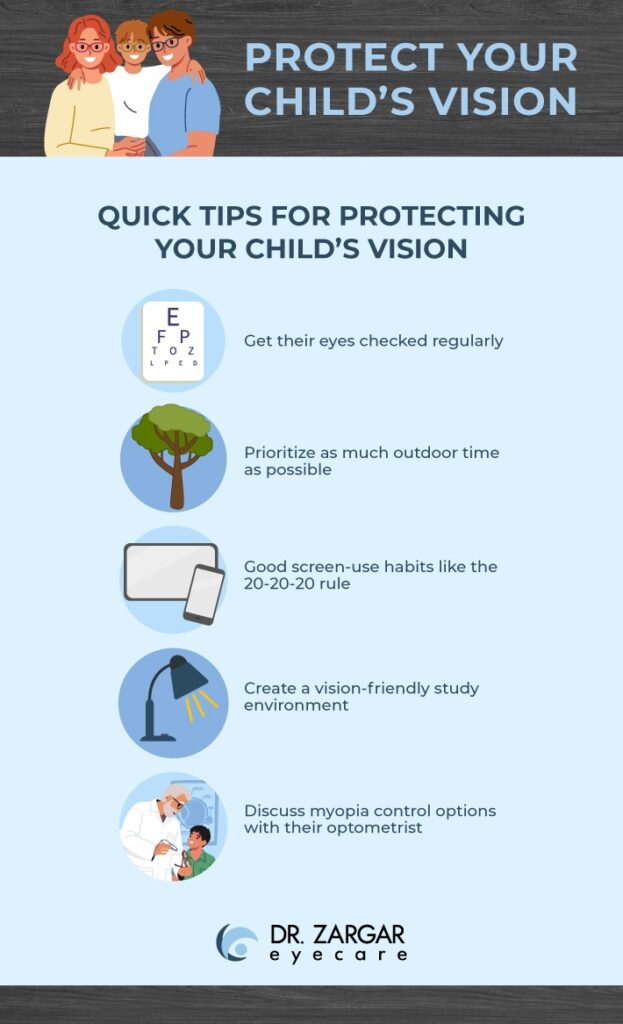The excitement of a new school year brings fresh notebooks and new teachers. But for many families, it also brings worsening nearsightedness in children. As students settle into their academic routines, parents often notice their kids squinting at the board or holding books closer to their faces.
This isn’t just a coincidence, the back-to-school transition can accelerate myopia progression. Between increased homework time, digital learning tools, and reduced outdoor play, September through June creates the perfect storm of contributing factors.
Understanding this connection empowers parents to take proactive steps. With the right knowledge and early intervention, you can protect your child’s vision and potentially slow down myopia progression during these critical learning years.
What Is Myopia?
Myopia, also known as nearsightedness, is a common refractive error where distant objects appear blurry while close objects can be seen clearly. This occurs when the eye grows too long or the cornea is too curved, causing light to focus incorrectly in front of the retina rather than directly on it.
Myopia often becomes noticeable in children when they struggle to see the board in a classroom, squint frequently, or move closer to screens and books. Other common symptoms include headaches, eye strain, and excessive blinking.
Early detection is important, as myopia can progress rapidly during childhood, leading to more severe vision problems later in life.
What Happens When Myopia Progresses?
Myopia progression refers to the gradual worsening of nearsightedness over time. Unlike a prescription change, myopia progression means your child’s eyes are actually growing longer than they should, causing distant objects to appear increasingly blurry.
Several factors drive myopia progression, with genetics playing a foundational role. If one parent has myopia, their child has an increased chance of developing it. But environmental factors have become increasingly influential in recent decades.
How School Life Fuels Myopia Progression
The transition back to school introduces several vision-challenging factors that can accelerate myopia progression in susceptible children.
Screen Time
Digital learning has transformed education, but it also means that children spend much more time looking at screens. Between interactive whiteboards, tablets for assignments, and computer-based testing, students now engage in significantly more screen-based near work than previous generations.
Near Work
Traditional school activities—reading textbooks, taking notes, completing worksheets—require prolonged focus on objects within arm’s reach. This sustained near work causes the eye muscles to work overtime, potentially contributing to the elongation of the eyeball that characterizes myopia progression.
Reduced Outdoor Time
Summer’s natural rhythm of outdoor play gives way to structured indoor learning during the school year. This shift matters more than many parents realize. Research shows that children who spend more time outdoors daily have lower rates of myopia development and slower progression.
When school schedules limit outdoor time, children miss this protective benefit during crucial developmental periods.

Protecting Your Child’s Vision During the School Year
The good news is that parents can take several practical steps to help manage myopia progression throughout the academic year.
Schedule Comprehensive Eye Exams
Annual eye exams are essential. Early detection of myopia allows for prompt intervention, which can significantly slow down myopia. Don’t wait for obvious signs like squinting or complaints about seeing the board—many children don’t realize their vision has changed.
Prioritize Outdoor Time
Even with busy school schedules, outdoor time remains one of the most effective ways to slow myopia progression. This doesn’t require structured sports—walking to school, playground time, or backyard activities all provide the beneficial bright light exposure.
Weekend outdoor adventures become even more valuable during the school year, helping offset the increased indoor time during weekdays.

Implement Smart Screen Habits
Since eliminating screen time isn’t realistic for modern students, focus on healthy screen habits instead. The 20-20-20 rule provides an excellent framework: every 20 minutes, look at something 20 feet away for at least 20 seconds.
Create Vision-Friendly Study Spaces
Good lighting reduces eye strain during homework time. Avoid working in dim light or with harsh overhead lighting that creates glare. Instead, use a desk lamp that illuminates work surfaces evenly while keeping screens glare-free.
Encourage regular breaks during study sessions. Even brief pauses to look out the window or walk around the room give the focusing muscles a chance to relax.
Treatment Options for Managing Myopia Progression
When lifestyle modifications aren’t sufficient to slow myopia progression, several myopia control options are available.
Myopia Control Contact Lenses & Eyeglasses
Contact lenses and eyeglasses for myopia control are often an effective option. We tend to recommend MiSight daily disposable contact lenses and MiYOSMART eyeglass lenses, which work by adjusting peripheral vision in a way that tells the eye to stop growing longer. This, in turn, slows myopia progression.
Orthokeratology (ortho-k) offers another contact lens solution. These specially designed rigid lenses are worn overnight to gently reshape the cornea, providing clear vision during the day without glasses or contacts while also slowing myopia progression.
Atropine Eye Drops
Low-dose atropine eye drops have shown success in slowing myopia progression. These drops work by affecting the eye’s growth mechanisms when used nightly at bedtime.
Multifocal Options
Multifocal glasses and contact lenses provide clear vision at all distances while incorporating design elements that may help slow eye growth. These options work particularly well for children who spend significant time on near-work activities.
Your Partner in Myopia Management
At Dr. Zargar Eyecare, we understand that managing myopia progression requires a comprehensive, individualized approach. Our team stays current with the latest research and treatment options to provide families with evidence-based strategies for protecting children’s vision.
We work closely with parents to develop realistic management plans that fit each family’s lifestyle while maximizing the potential to slow myopia progression. From contact lens fittings to lifestyle counselling, we’re committed to giving your child the best possible vision outcomes.
Schedule your child’s eye exam now and get ahead of potential vision issues with proven myopia management.

